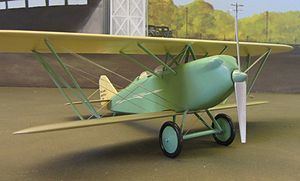First flight 1926 Designer Agnew E. Larsen | Manufacturer Pitcairn Aircraft Company | |
 | ||
The Pitcairn PA-2 Sesquiwing "Arrow" is an early biplane designed for air racing and commercial airmail service.
Contents
Design
The Sesquiwing featured a quick change motor mount to accommodate a Curtiss C-6 or Curtiss OX-5 engine, and wheel fairings for speed.
Operational history
A specially built PA-2 was flown by Jim Ray in the 1926 Ford National Reliability Air Tour. It placed second in a race for engines under 800 cubic inches displacement, then it had its engine swapped to an OX-5 for a race the next day, and again back to a Curtiss C-6 engine the next day to win the Detroit race.
Specifications (Pitcairn PA-2 Sesquiwing - C-6 engine)
Data from The Pitcairn Sesqui-Wing
General characteristics
Performance
References
Pitcairn PA-2 Sesquiwing Wikipedia(Text) CC BY-SA
